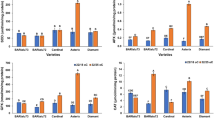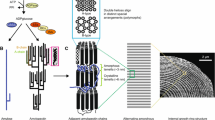Abstract
The molecular basis for the selectivity of protein degradation has been examined in osmotically stressed and senescent barley leaves. Relatively weak correlations between the in-vivo rate of loss of enzyme activity, and the charge and molecular weight of the enzymes ahve been detected. We interpret these correlations as supporting the view that the selectivity of enzyme degradation is the result of the physical properties of the enzymes being degraded. The weakness of the correlates is taken to mean that a number of properties which contribute to the selectivity are independent of one another. Under in-vitro conditions (autolysis at 0° C), the loss of enzyme activity was weakly correlated with the charge of the enzymes. However, there was a general similarity between the in-vivo pattern of loss of enzyme activity and the in-vitro patterns under a number of conditions. Furthermore double-isotope experiments demonstrated that the in-vivo degradation of soluble protein was reflected by in-vitro degradation under a number of conditions. Consequently we conclude that the selectivity of protein degradation is largely independent of the nature of the proteolytic system.
Similar content being viewed by others
References
Acton, G.J., Gupta, S. (1979) A relationship between protein degradation rates in vivo, isoelectric points, and molecular weights obtained by using density labelling. Biochem. J. 184, 367–377
Arias, I.M., Doyle, D., Schimke, R.T. (1969) Studies on the synthesis and degradation of proteins of the endoplasmic reticulum of rat liver. J. Biol. Chem. 244, 3303–3315
Barnett, N.M., Naylor, A.W. (1966) Amino acid and protein metabolism in Bermuda grass during water stress. Plant Physiol. 41, 1222–1230
Batt, T., Woolhouse, H.W. (1975) Changing activities during senescence and sites of synthesis of photosynthetic enzymes in leaves of labiate Perilla frutescens (L). J. Exp. Bot. 26, 569–579
Berlin, C.M., Schimke, R.T. (1965) Influence of turnover rates on the responses of enzymes to cortisone. Mol. Pharmacol. 1, 149–156
Betz, B., Schäfer, E., Hahlbrock, K. (1978) Light-dinduced phenylalanine ammonia-lyase in cell-suspension cultures of Petroselinum hortense. Arch. Biochem. Biophys. 190, 126–135
Bohley, P., Kirschke, H., Langner, J., Widerands, B., Ansorge, S., Hanson, H. (1977) Primary reactions of intracellular protein catabolism I. In: Intracellular protein catabolism II. 2nd Int. Symp. J. Stephan Inst., Liubljana, Yugoslavia, pp. 108–110, Turk, V., Marks, N., eds. Plenum Press, New York
Cooke, R.J., Davies, D.D. (1980) General characteristics of normal and stress-enhanced protein degradation in Lemna minor (duckweed). Biochem. J. 192, 499–506
Cooke, R.J., Roberts, K., Davies, D.D. (1980) Model for stressinduced protein degradation in Lemna minor. Plant Physiol. 66, 1119–1122
Dao, M.L., Watson, J.J., Delaney, R., Johnson, B.C. (1979) Purification of a new high activity form of glucose-6-phosphate dehydrogenase from rat liver and the effect of enzyme inactivation on its immunochemical reactivity. J. Biol. Chem. 243, 9441–9447
Davies, D.D. (1982) Physiological aspects of protein turnover In: Encyclopedia of plant physiology, N.S., vol 14A: Nucleic acids and proteins in plants I, pp. 189–228, Boulter, D., Parthier, B., eds. Springer, Berlin Heidlberg New York
Dice, J.F., Goldberg, A.L. (1975) Relationship between in vivo degradative rats and isoelectric points of proteins. Proc. Natl. Acad. Sci. USA 72, 3893–3897
Dice, J.F., Walker, C.D., Byrne, B., Cardiel, A. (1978) General characteristics of protein degradation in diabetes and starvation. Proc. Natl. Acad. Sci. USA 75, 2093–2097
Duncan, W.E., Offermann, M.K., Bond, J.S. (1980) Intracellular turnover of stable and labile soluble liver proteins. Arch. Biochem. Biophys. 199, 331–341
Goldberg, A.L., St. John, A.C. (1976) Intracellular protein degradation in mammalian and bacterial cells, pt. 2. Annu. Rev. Biochem. 45, 747–703
Hahlbrock, K., Knobloch, K.-H., Kreuzaler, F., Potts, J.R.M., Wellman, E. (1976) Coordinated induction and subsequent activity changes of two groups of metabolically interrelated enzymes. Eur. J. Biochem. 61, 199–206
Igaue, I., Tamura, H., Endo, K., Saito, K. (1981) Aggregated forms of glucose-6-phosphate dehydrogenase from cultured rice plant cells. Plant Cell Physiol. 22, 311–316
Kahn, F.R., Saleemuddin, M., Siddiqi, M., McFadden, B.A. (1979) The appearance and decline of isocitrate lyase in flax seedlings. J. Biol. Chem. 254, 6938–6944
Mann, D.F., Shah, K. (1979) Correlation of rat liver enzyme half-life with retention in detergent affinity columas (Abstr. 979) Fed. Proc. 38, 414
Matile, P.H. (1982) Protein degradation. In: Encyclopedia of plant physiology, N.S., vol. 14A: Nucleic acids and proteins in plants I, Boulter, D., Parthier, B., eds. Springer, Berlin Heidelberg New York
Racker, E. (1962) Ribulose diphosphate carboxylase from spinach leaves. Methods Enzymol. 5, 266–270
Richards, L., Thurston, C.F. (1980) Protein turnover in Chlorella fusca var vacuolata: measurement of the overall rate of intracellular protein degradation using isotope exchange with water. J. Gen. Microbiol. 121, 49–61
Segal, H., Kim, Y.S. (1963) Glucocorticoid stimulation of the biosynthesis of glutamic-alanine transaminase. Proc. Natl. Acad. Sci. USA 50, 912–918
Sorger, G.J., Debanne, M.T., Davies, J. (1974) Effect of nitrate on the synthesis and decay of nitrate reductase of Neurospora. Biochem. J. 140, 395–403
Stoddart, J.L., Thomas, H. (1982) Leaf senescence. In: Encyclopedia of plant physiology, N.S., vol. 14A: Nucleic acids and proteins in plants I, pp. 592–636, Boulter, D., Parthier, B., eds. Springer, Berlin Heidelberg New York
Tanaka, Y., Uritani, I. (1977) Synthesis and turnover of phenylalanine ammonialyase in root tissue of sweet potato injured by cutting. Eur. J. Biochem. 73, 255–260
Thomas, H. (1978) Enzymes of nitrogen mobilization in detached leaves of Lolium tementulum during senescence. Planta 142, 161–169
Wolf, D.H. (1982) Proteinase action in vitro versus proteinase function in vivo: mutants shed light on intracellular proteolysis in yeast. TIBS 7, 35–37
Yamane, T. (1967) Statistics; an introductory analysis, 2nd edn. Harper & Row, Weatherhill
Author information
Authors and Affiliations
Rights and permissions
About this article
Cite this article
Coates, J.B., Davies, D.D. The molecular basis of the selectivity of protein degradation in stressed senescent barley (Hordeum vulgare cv. Proctor) leaves. Planta 158, 550–559 (1983). https://doi.org/10.1007/BF00397246
Received:
Accepted:
Issue Date:
DOI: https://doi.org/10.1007/BF00397246




